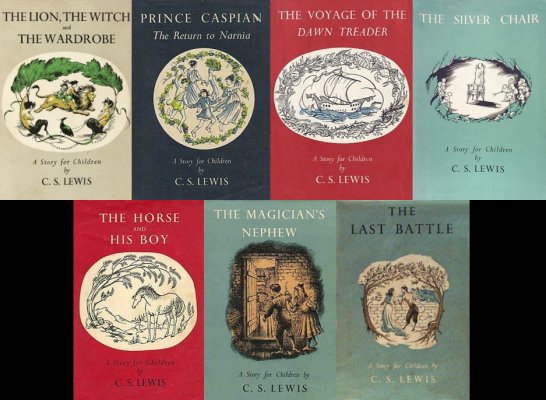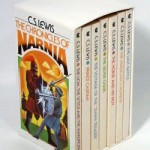
 This is one of the questions that we always seem to get, and while I have it listed on the books page, I think it’s prudent to write something new about it, since there are so many that are now picking up the Chronicles of Narnia books for the first time.
This is one of the questions that we always seem to get, and while I have it listed on the books page, I think it’s prudent to write something new about it, since there are so many that are now picking up the Chronicles of Narnia books for the first time.
There are many in the current generation that are unaware that there is an order discrepancy at all, because the books were re-numbered after C.S. Lewis had died, into near-chronological order. I say near-chronological, because they can never truly be chronological, as The Horse and His Boy (HHB) takes place at some time during the final few pages of The Lion, the Witch and the Wardrobe (LWW). Thus, to truly read them in chronological order, you’d need to stop reading LWW at a certain point, then read the whole of HHB before heading back into the final parts of LWW.
This brings me to my opinion, which is widely held and regarded by many as the only way to read the Chronicles of Narnia if you are venturing into them for the first time. The original order of publication.
You see, Lewis started the series with The Lion, the Witch and the Wardrobe. It is evidenced by not just the date of publication, but also by the language which Lewis uses as the narrator. When they are in the home of Mr. and Mrs. Beaver, the first mention of Aslan occurs:
“They say Aslan is on the move – perhaps has already landed.”
And now a very curious thing happened. None of the children knew who Aslan was any more than you do; but the moment the Beaver had spoken these words everyone felt quite different.
Did you notice something peculiar about that? If you had started with The Magician’s Nephew, then you, the reader, would know who Aslan was. The narrator would not have said “None of the children knew who Aslan was any more than you do.” Why would the narrator make an assumption so great if he had just told you the story of The Magician’s Nephew? Imagine if you were being told the stories by someone live on stage, would that line make much sense to include?
No, and neither would the following:
“But if the Professor was right it was only the beginning of the adventures of Narnia.”
Note that it doesn’t say “their” adventures in Narnia, which would indicate the Pevensies. It says “the,” meaning adventures in general. It was the beginning of the adventures, indicating that there had been no previous adventures. It doesn’t mean that there couldn’t have been previous adventures in Narnia, just that we haven’t read about these adventures yet.
In The Magician’s Nephew, which is itself a prequel to the entire series, you read about the logical origins of many things that show up throughout the series in big and small ways. Sure, you might think it would be nice to know these things prior to reading about them in the rest of the series, but you’ll also miss a lot. Here’s why: you won’t care.
You won’t care about the various and random things that happen throughout the story and are seemingly thrown in for no apparent reason. You won’t care about the little details that the narrator talks about, and quite frankly, you’ll wonder why some events are even mentioned at all. Sure, it lays the groundwork and is foreshadowing the events to come, and that is what every good writer should do. The difference here is that there is so much foreshadowing that it can manage to suck all of the mystery out of certain things that happen later in the story, including Aslan, the Wardrobe and the Lamp-post.
You could make the argument that the movie is popular enough that it isn’t spoiling anything. However, for those that have not seen the movies, nor read the books, all of this is very important to take into account.
So, what is the original publication order?
It’s kind of like an American phone number: 2456317.
When Lewis started writing the books, he didn’t really have much of a plan for the complete series. In fact, if he didn’t find inspiration for four more books, The Voyage of the Dawn Treader would have been the end of the series. This would have altered a lot of other book series to come later, as J.K. Rowling has stated that her primary reason for writing seven Harry Potter novels was inspired by and in honor of the seven Chronicles of Narnia. That was not a coincidence, but an intentional decision she made as a fan of Narnia. (This is also quite ironic considering the various Christian groups that condemned the Potter series, but that’s not what we’re talking about here so please refrain from comment on that topic.)
Here are the books in Publication Order:
The Lion, the Witch and the Wardrobe (1950)
Prince Caspian (1951)
The Voyage of the Dawn Treader (1952)
The Silver Chair (1953)
The Horse and His Boy (1954)
The Magician’s Nephew (1955)
The Last Battle (1956)
There’s an interesting bit of trivia that comes about when you do some research into the writing of the chronicles. Lewis wrote the books in the publication order, yes, but The Magician’s Nephew was one that he had trouble with. He actually finished The Last Battle first. Moving on to the final book in the midst of writing The Magician’s Nephew afforded him a look at what would occur at the end of the series. He reportedly scrapped much of what he had originally written for The Magician’s Nephew and re-wrote much of it, finishing that book last.
When I was a kid, our school library had all of the Narnia books. I found them because I enjoyed the animated version of The Lion, the Witch and the Wardrobe and was watching the BBC ones. I was very confused, however, by the numbering of the books. You see, the library had many copies of each of them, some were numbered with the original publication order, and some with the modified chronological order. This actually served to put me off of reading the books for many years. I couldn’t make heads or tails of the numbers, nor was there an explanation to be found for the different numbers on the sides of the books. Seeing both The Lion, the Witch and the Wardrobe and The Magician’s Nephew with the words “Book 1 in the Chronicles of Narnia” was very confusing to me.
The chronological order of the books is the following:
1. The Magician’s Nephew
2. The Lion, the Witch and the Wardrobe
3. The Horse and His Boy
4. Prince Caspian
5. The Voyage of the Dawn Treader
6. The Silver Chair
7. The Last Battle
This is the order that you’ll find all of the books that are published today. The single book edition also features them in this order.
The Star Wars Argument
Now, there’s a very similar situation that has happened in the world of film. The original Star Wars trilogy features episodes 4-6: A New Hope (1977), The Empire Strikes Back (1980) and Return of the Jedi (1983). The prequel trilogy, with episodes 1-3 came much later: The Phantom Menace (1999), Attack of the Clones (2002) and Revenge of the Sith (2005).
There are some that believe that watching the movies in chronological order is the correct way to watch them the first time through. However, it definitely robs you of the experience of learning what happened to Luke Skywalker’s father for the first time. This was one of the most shocking twists in motion picture history. Watching the movies in the original production order is definitely the only way to go when you are watching them for the first time.
In much the same way, I feel that the first time through the Chronicles, dive into them in the original publication order. It’s not going to be hard to follow what is happening. You are capable of keeping track of where the book you’re reading falls on the timeline. In fact, you already have to keep that in mind when reading The Horse and His Boy.
The Lord of the Rings and The Hobbit
Another series of films is about to increase to five, but watching them in chronological order isn’t going to change a thing. The Lord of the Rings was written well after The Hobbit and the opposite is true of the movies. They filmed The Lord of the Rings over ten years ago, and are going to begin shooting The Hobbit movies in a matter of months. I am quite sure that it won’t make a difference which order you watch the films. While chronologically The Hobbit comes first, each story is very stand-alone. One story follows Bilbo and the other Frodo, but watching The Hobbit first will spoil nothing in The Lord of the Rings. In fact, it’ll bring everyone in on Gandalf’s joke about Bilbo at the beginning of The Fellowship of the Ring:
“If you’re referring to the incident with the dragon, I was barely involved. All I did was give your uncle a little nudge out of the door.”
 The First Time You Read Narnia
The First Time You Read Narnia
So, the first time that you read The Chronicles of Narnia, I hope that you give the original publication order a chance. I have had too many friends tell me they tried starting with The Magician’s Nephew and giving up, finding it a very boring book. If you’d like to avoid a similar fate, then I recommend that you memorize this number: 245-6317 (in phone number format to make it easier to recall). I am sure that you’ll be glad you did.


About the letter:
“Scholars and readers who appreciate the original order believe that Lewis was simply being gracious to his youthful correspondent and that he could have changed the books’ order in his lifetime had he so desired”
FACTS:
Clive Staples Lewis (29 November 1898 – 22 November 1963)
The Last Battle published in 1956
SEVEN YEARS… (they published the seven books in SIX)
PS: Star Wars in chronological order???????? What about “(Luke) I am your father”???? (one of the most memorable scenes on film history). It was a shock even for David Prowse!!
this is an interesting suggestion but which order to watch them in for only the pevensie children have been produced in the films apart from dawn treader
So I was looking at my narnia box set today and naturally it was in the HarperCollins Chronological order. And I was reading the Pocket Companion to Narnia book and they suggest that the best reading order is LWW, PC, VDT, HHB, SC, MN, and TLB. They call it “order by essential completion” meaning that that was the order that the stories came to touch Lewis’ heart and mind, as they say. And so I put my books in that order. Then I looked at it for a while admiring my new (better) order, when I realized that I actually disagree with that order and so I again changed it to make my preferred reading order that I call “Order by Respect of Inspiration and Continuity”:
The Lion, the Witch, and the Wardrobe
Prince Caspian
The Voyage of the Dawn Treader
The Silver Chair
The Magicians Nephew
The Horse and His Boy
The Last Battle
Now here’s why I did this: I agree with following Lewis’ original order rather than chronological, however, from a readers perspective, the “better” order (pocket companion order mentioned previously) is awfully confusing. A lot of back and forth. So I decided to do this which seemed to be the best for the reader to mentally handle and best for story structure. I put the “pevensie trilogy” (LWW, PC, VDT) first, then the “Caspian Trilogy” (PC, VDT, SC) second rather than interrupting the continuation between Voyage and Chair with HHB. So from there I have put together the four books that make up a direct story continuation beginning to end. Then the last three are what I call the “Oddball Trilogy”. These are the ones that each have different characters that don’t really transfer over to any of the other books. Now, publication order says to put these HHB, MN, TLB, but I again found that to be a lot of gear shifting for a reader time-wise, so I put them in their own chronology: MN (the creation story), HHB (an in between story), and finally TLB (the end of all Narnia), Making those three a self contained continuous trilogy. There ya go. I hope you like my order and try it out! =]
I have read the books before (well to be fair, my mother read them to me as a child so it’s been awhile..) and I’ve seen most of the film adaptions of them as well- I’m not new to the series. However I just ordered the set to re-read and obsess for awhile, and have been thinking ALL DAY in what order I’d like to read them! I think your order makes a lot of sense as far as groupings and characters go. Thanks for the input!
Speaking from personal experience, I can understand the “wonder element” that is encouraged by reading the books in publication order – that was how I first read the books. However, it also leads to confusion to be jumping back and forth between the Narnian timeline. For that reason, I personally am a proponent of the chronological order.
Luckily, when these were first read to me as a child, it was from a set numbered in the original publication order. This is what I prefer, and whether or not others agree it seems to me that publishers should not be numbering them on the spine as they almost always seem to – that way you can put them into whatever order you like. I haven’t yet, but I was thinking of ordering the first edition fascimile editions, which don’t appear to be numbered. They have the Pauline Baynes illustration, in color, and are the closest I’ll probably ever get to a first edition copy. (I already have the first Oz book, and The Wind in the Willows fascimile first editions.)
Anyway, it’s funny – I’ve read some pretty heated arguments over the reading order, but my solution of publishers just not putting numbers right on them solves the problem.
P.S. I was robbed of that Star Wars twist. That scene had a lot less impact already knowing Vader was Luke’s father (I also already knew the secret of The Sixth Sense, and while I haven’t seen it I already know the twist to The Crying Game). Knowing that, it seemed weird how they talked about Luke in the first movie, as though they weren’t aware he was Vader’s son (odd, since in addition to having the name Skywalker, he also grew up on the exact same planet Vader grew up).